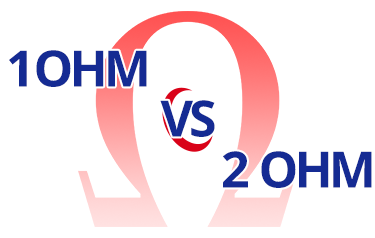Free Shipping*
Lower 48. Orders over $100.
2 Year Warranty
On all our radios.

Your cart is currently empty.

When selecting your subwoofers and the amplifier to power them, there are so many choices. There are single 4-ohm voice coils, single 2-ohm voice coils, even single one-ohm voice coils. Then there are dual voice coil subwoofers with dual 2-ohm, dual 4-ohm, dual 8-ohm, or dual 1-ohm voice coils. The subwoofers you select and how you wire them will determine the impedance or load, that the amplifier sees. Usually, subwoofers are wired to either a 1 ohm or 2-ohm load in order to maximize the power output from the amplifier.
But, is it better to run an amplifier at 1 ohm or is it better to buy the bigger amplifier and run it 2 ohms?
The difference between a 1-ohm and 2-ohm will depend on your amplifier. The difference in the power output may be as little as 10% or, you might see twice the power at 1 ohm that you do at 2 ohms. Additionally, on some amplifiers like the JL Audio HD series or the Rockford Fosgate Power Series, the output is the same at 1 ohm, 2 ohms, and even 4 ohms. The output difference between 1, 2, and 4 ohms will vary depending on the amplifier brand, amplifier model, and the technology.
Ohm's Law.The first place to start is with Ohm's law. Ohm's law states "Voltage equals the current multiplied by the resistance."
E=IRwhere:
Let's assume the voltage remains constant at 12V. Cars are considered "12 volt" but most are running at 14+ volts when the car is on and the alternator is running.
12 Volts = I x 4.
If we divide 12 by 4, we get 3 amps of current.
12 Volts = I x 2.
Again, we will divide 12 by 2 and we have 6 amps of current
12 Volt = I x 1
We have 12 amps of current.
Equation for Power
Power is measured in watts. Power equals the voltage multiplied by the current. W = V x A
Since on a car, we will assume it is 12 volts and the vehicle is not running. So from the equation above:
At 4 ohms we have 3 amps. 3 x 12 = 36 Watts.
At 2 Ohms we have 6 amps, 6 x 12 = 72 watts.
At 1 ohm we have 12 amps, 12 x 12 = 144 watts.
As you can see, as you drop the resistance, the power output in watts increases. But as we saw above, as resistance decreases, current increases, and therefore power increases.
Now amplifiers are not all the same and the circuit design is not always linear. You might see 300 watts at 4 ohms, 600 watts at 2 ohms, and 800 watts at 1 ohm. This is a situation where they limit the current draw in order to make sure that the amplifier does not overheat and burn itself out.
Unfortunately, the answer is "It Depends." The right answer for you will depend on the subwoofers, the amplifier, your budget, and what you are trying to do. Are you going for the best possible sound quality? Are you looking to maximize bass output for your money? Will your ear be able to tell the difference in sound quality?
The case for 1 Ohm: Maximum VolumeIf you like loud bass, and you are trying to get maximum output for your money while also getting maximum output from your subwoofer(s), get an amplifier that is 1 ohm stable, and select subwoofers that will allow you to wire them to a 1-ohm load. At 1 ohm, you will get more power output from your amplifier and your subwoofers will play louder than if you wired them to a 2-ohm load. There is no substitute for power if you are looking for maximum volume and at 1 ohm, the amplifier will put out more power.
Costs Less = More Power Output per $You can also save some money by wiring your subwoofers to a 1-ohm load. Let's say you have a Rockford Fosgate subwoofer that can handle 500 watts. You could run a P500x1bd at 1 ohm, or you could run a P1000x1bd at 2 ohms. The P500x1bd costs $ 429.99 and theP1000x1bdcosts $549.99. The P500x1bd will put out 787 watts of dynamic power on the birth certificate, and you will have more than enough power. The P1000x1bd will put out 874 watts at 2 ohms on the birth certificate. That is even more power than you need. So, you can save some money with the cost of your amplifier by getting more amp for your money, if you will, when you power it at 1 ohm.
The case for 2 ohms: Less Current = Less HeatWhen you wire your amplifier to a 1 ohm load, the amplifier is pushing its limit with the amount of current it draws from your vehicle's electrical system. More current means more heat and more heat leads to more distortion. While not a perfect analogy, think of a 1-ohm load as if you are flooring the car everywhere you go. You are getting maximum horsepower and output from the engine all the time. Now, most people don't drive that way because it is unnecessary wear and tear on the engine. Wiring the subwoofers to a 2 ohm load is going to draw less current, the amp will run cooler, and the amplifier is not going to have to work as hard as it would if it was wired to a 1 ohm load.
Better Sound QualityWhen you hear demo vehicles from all of the big car audio brands, they are never wired to a 1 ohm load. They always wire them to a 2+ ohm load and overpower the the subwoofers for the cleanest possible sound. But, they also aren't paying retail for those products. They are being written off as "marketing budget." The million dollar question here is whether or not your ear will notice the difference.
ConclusionWiring your subwoofer to a 2 ohm load is going to be more expensive than wiring them to a 1-ohm load. We find that most of our customers are looking for maximum output for their money. Sure, there are audiophiles looking for the best possible sound quality, but if you are all about the amount of bass and how hard your subwoofers hit, go with a 1-ohm stable amplifier. Make sure you have or buy subwoofers that allow you to wire them to a 1-ohm load, and you are going to get more power for your money. Power is power, is power when it comes to bass.
Very few people have a well-trained ear to truly hear the difference. If you are entering SQ (Sound Quality) competitions, you probably aren't reading this article. Otherwise, you want maximum bass output for your money, and wiring to a 1 ohm load will do that.
Think of it as a Ford F-150 vs a Porsche 911, and both vehicles are going 100 mph. The Ford F-150 can do 100 mph and it's still comfortable. It's not necessarily screaming, but it's working harder than the Porsche is working. Meanwhile, the Porsche 911 is going 100 mph and it is smooth as butter. Both vehicles can easily go 100 mph. The truck is like wiring to a 1-ohm load and the Porsche is like wiring to a 2-ohm load. The truck is going 100 and costs significantly less than the Porsche does, and both cars are going at the same speed.
You can also use the same comparison with brakes. Let's say both a Porsche 911 and a Ford F-150 are going 100 mph and all of the sudden traffic comes out of nowhere. Which car is going to stop faster and with more control? The Porsche 911. All things considered at 100 mph, the Porsche 911 has much better control, comfort, and stopping power than the truck does. The Porsche would be wiring the subwoofers at 2 ohms and the truck would be wiring the subwoofers at 1 ohm.
Most people aren't driving 100 mph everywhere they go and don't necessarily NEED a Porsche 911. If you just need to go 100 mph, you can do that just fine with the F-150.
Additional Resources
Shop 1 Ohm Stable Subwoofer Amplifiers
Shop All Subwoofer Amplifiers
Subwoofer Amplifier Impedance Chart
Subwoofer Wiring Wizard
Single vs. Dual Voice Coil Subwoofers
Copyright © 2026 ClassicCarStereos.com